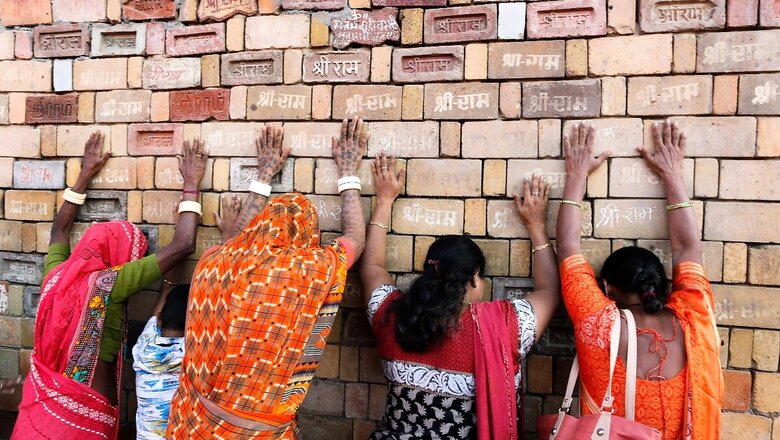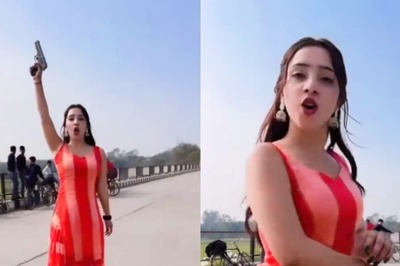
views
On August 5, as Prime Minister Narendra Modi will lay the first foundation brick for the Ram temple in Ayodhya, India will look forward to a fresh start. A new beginning beyond the protracted, communally charged Ram Janmabhoomi-Babri Masjid dispute. An issue which had somewhat constricted the country’s socio-political discourse for about four decades. However, away from politics, the legal battle over the piece of land in Ayodhya where the Babri Masjid once stood, will surely go down in history as one of the longest ones of our country.
On November 9 last year, the Supreme Court’s five-judge bench headed by the-then Chief Justice Ranjan Gogoi delivered its historic judgement in the case that has continued to surface and linger on in some form in different courts from the time of India’s independence in 1947, and before that for almost 90 years during British rule.
The SC in a unanimous verdict ordered for handing over of the disputed 2.77-acre land to a trust that would handle the construction of the temple. The trust was to be constituted by the central government. As the top court’s verdict finally brought closure in the matter, the legal ups and downs, manoeuvrings, and decisions, all have become part of history. Here is a timeline of how the dispute began and how it gradually moved to the Supreme Court, which in turn brought about the conclusion.
THE BEGINNING
1857: It was the year of India’s first struggle for independence against the British Raj. However, the seeds of another controversy were sown quietly some 130 km from Lucknow in Faizabad district. The temple town of Ayodhya fell under this district. A petition was submitted before the magistrate of Faizabad by Maulvi Muhammad Asghar, the muezzin of Babri Masjid, alleging that the eastern part of the courtyard of the mosque had been forcibly taken over by the Mahant of Hanuman Garhi.
Hanuman Garhi was an important centre of religious life in Ayodhya, especially for Vaishnav Bairagis. The complaint by the muezzin marked the beginning of a legal dispute over the place. However, it was still several years before the land on which the mosque stood was to be officially declared as “disputed land”.
1859: The British government made its first intervention in the matter, while hearing the petition filed in 1857 and keeping in mind the regional conflict. The administration got a wall built that separated the places of worship for Muslims and Hindus. The Hindus got entry to the courtyard through the east gate, while the Muslims had access to the mosque from the northern side.
1860-1884: During this period, the Muslim side filed similar petitions like it did in 1857 and complained about the increasing interference of some local seers and sadhus and illegal occupation of land. These petitions were made in 1860, 1877, 1883 and 1884. All of them were rejected.
1885: The first legal representation was made by someone from the Hindu side. Mahant Raghubar Das filed a suit to gain legal title to the land and for permission to construct a temple on the ‘chabutara’ (raised platform) in the eastern courtyard. The petitioner claimed himself to be the mahant of the ‘janmasthan’ (birthplace) of Lord Ram and said the ‘chabutara’ was the Lord’s birthplace.
Hence, according to this first representation, the 'chabutara' and not the land where the actual mosque stood, was claimed to be Ram’s birthplace.
1886: The suit filed by Das was dismissed. However, rulers of the day had started seeing it as a Hindu-Muslim controversy of significant proportion.
1870-1923: As the dispute spread further, several official publications of the time started taking note of it. It was even mentioned in some of the gazettes published at the time. A stone marker reading “No 1 Ram Janmahoomi” was placed at the main entrance of the mosque.
FROM BRITISH RAJ TO INDEPENDENT INDIA
Dispute Intensifies
December 22-23, 1949: On the intervening night of December 22-23, idols of Ram and Lakshman were placed inside Babri Masjid. A crowd built up and started performing 'kirtan' (religious songs) inside the mosque.
December 29, 1949: A judge of Faizabad district court declared Babri Masjid a “disputed property” and ordered that status quo be maintained. Muslims were barred from entering the mosque and its main gate was locked. Hindus got permission for darshan from a side gate and four pujaris were employed with access to idols.
January 16, 1950: A member of the Hindu Mahasabha, Gopal Singh Visharad, filed a civil suit, seeking permission for worship without obstruction and permanent ban on removal of idols.
1959: The Nirmohi Akhara filed a suit claiming that the entire structure be transferred to it as it was a temple and not a mosque.
December 18, 1961: The Sunni Central Waqf Board filed a suit demanding that Babri Masjid be handed over to it.
February, 1986: Locks of Babri Masjid opened by orders of the district judge of Faizabad.
1987: Suits withdrawn from Faizabad and transferred to the Lucknow bench of Allahabad High Court. The suit filed by Visharad became the number one suit. Another suit (number two) was filed by Paramhans Ramchandra Das (withdrawn later). The third suit was the one filed by Nirmohi Akhara and the fourth one was by the waqf board.
1989: ‘Ram Lalla’ himself became a party. The fifth suit was filed by one Deoki Nandan Agarwal in the name of ‘Ram Lalla Virajman’. Agarwal filed it as a ‘sakha’ (friend) of Ram Lalla.
DEMOLITION AND THEREAFTER
December 6, 1992: Babri Masjid demolished by thousands of Hindu ‘kar sevaks’ (volunteers) even as helpless security forces watched the structure being brought down. Two FIRs were filed the same day. One of them (crime number 197) was lodged at 5.15pm against the “lakhs of karsevaks” for the offence of demolition.
The second FIR (crime number 198) was filed against eight individuals, namely LK Advani, MM Joshi, Uma Bharti, Ashok Singhal, Giriraj Kishore, VH Dalmia, Vinay Katiyar and Sadhvi Ritambhara. They were accused of making provocative and inflammatory speeches before the demolition. The cases were filed at the Ram Janmabhoomi police station.
December 16, 1992: The Centre formed the one-man commission of Justice Manmohan Singh Librahan to look into the sequence of events leading to the demolition and all the facts and circumstances relating to the events that transpired in the Ram Janmabhoomi-Babri Masjid Complex on December 6.
January 7, 1993: The President of India, through an ordinance, issued orders for acquisition of certain areas around the disputed site. It was later re-enacted as an act of Parliament. On the same day of issuing the ordinance, the President also referred it to the Supreme Court for its advisory opinion.
1993-2002: Hearing gained pace in the title suit case in the Lucknow bench of the Allahabad High Court. A long-drawn battle began as parties concerned started presenting their arguments.
August 1, 2002: Focus shifted back to the title suit as the high court ordered the Archaeological Survey of India (ASI) to initiate excavation at the disputed site.
Dec 2002-August 2003: ASI began excavation at the disputed site on December 30, 2002. It did a preliminary survey and submitted its report to the ASI director general. It suggested a variety of anomalies ranging from 0.5m to 5m in depth that could be associated with some ancient and contemporary structures. On the basis of the preliminary findings, a detailed digging and examination was started. The ASI submitted its report in two volumes before the court in August 2003.
VERDICT THAT NO PARTY ACCEPTED
July 26, 2010: A three-judge bench of the Allahabad High Court, comprising Justices SU Khan, Sudhir Agarwal and DV Sharma, reserved their order on the Ayodhya land title suit.
September 30, 2010: The three-judge bench delivered the much-awaited judgment. The court divided the disputed land equally between the three major parties concerned, i.e., the Sunni Waqf Board, Nirmohi Akhara and Ram Lalla Virajman. However, none of the parties was satisfied with the verdict.
MATTER IN SUPREME COURT
May 9, 2011: Appeals against the high court orders came up for mentioning in the Supreme Court. Almost all the parties concerned filed appeals against the high court order. Later, the apex court put a stay on the HC order.
2011-2016: It’s a period of comparative quiet even as voices in the political arena continued to rise for a judgement in the case pending before the SC.
FINAL COUNTDOWN
2017-2019: First, under Chief Justice Deepak Misra and then, under CJI Ranjan Gogoi, the apex court shifted focus towards the title dispute case. Justice Misra retired in 2018 before regular hearing in the case could begin.
2018: After assuming office in October 2018, CJI Ranjan Gogoi expressed his willingness for a speedy hearing and judgment in the long-pending case.
January, 2019: The CJI constituted a five-judge bench, including himself, to begin hearing in the case.
LAST EFFORTS AT MEDIATION
March 2019: The Supreme Court bench hearing the Ayodhya matter constituted a three-member mediation panel, comprising (retired) SC judge FM Khalifulah, Art of Living head Sri Sri Ravi Shankar and senior advocate and trained mediator Sriram Panchu.
August 2019: On August 2, the mediation committee informed the Ayodhya bench that the parties concerned had failed to reach an agreement. The Supreme Court then fixed August 6 for commencement of day-to-day hearing in the matter.
DAY-TO-DAY HEARING
October 16, 2019: Starting August, the bench regularly took up daily hearings of the case for 40 days. October 16 was fixed as the last date for the parties to submit their argument. The legal battle that had continued in courts of independent India for almost 70 years reached culmination with hearing being completed in the country’s top-most court.
JUDGEMENT DAY
November 9, 2019: Five-judge bench headed by Chief Justice Ranjan Gogoi and comprising Justice DY Chandrachud, SA Bobde, S Abdul Nazir and Ashok Bhushan deliver the much awaited judgement in the case. It was a unanimous decision. The bench ordered for allocation of the entire disputed land of 2.77 acres for the construction of a temple. The union government was to constitute a trust to oversee it.
The court in its judgement observed that archaeological evidence from the ASI showed that Babri Masjid was constructed on a structure whose architecture was indigenous and non-Islamic. The court also said that Muslim parties including the Sunni waqf board had failed to establish the exclusive possession of the disputed land.
The bench also ordered for allocation of 5 acres of land to the waqf board in the district of Ayodhya itself, for the possible construction of a mosque. Even as the way for temple construction was cleared, the court also ruled that the demolition of the Babri Masjid in 1992 and its desecration in 1949 was in violation of the law.




















Comments
0 comment